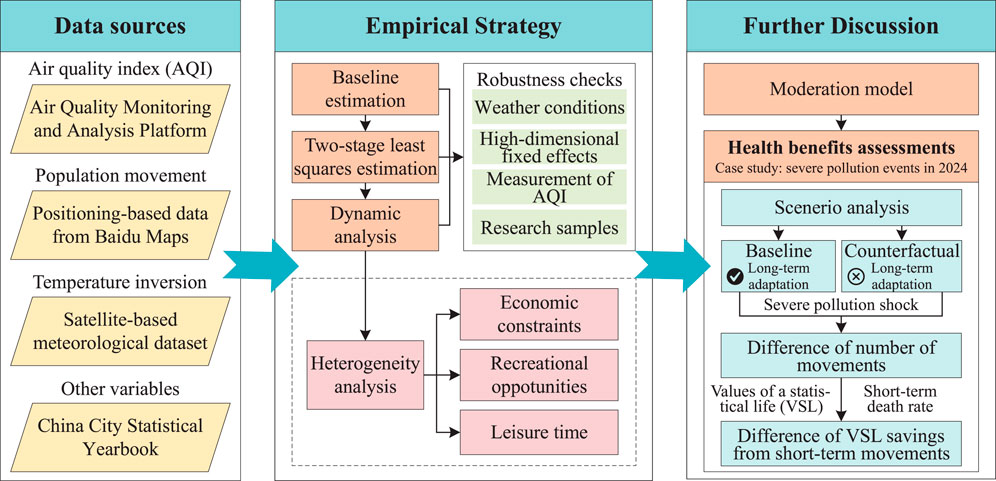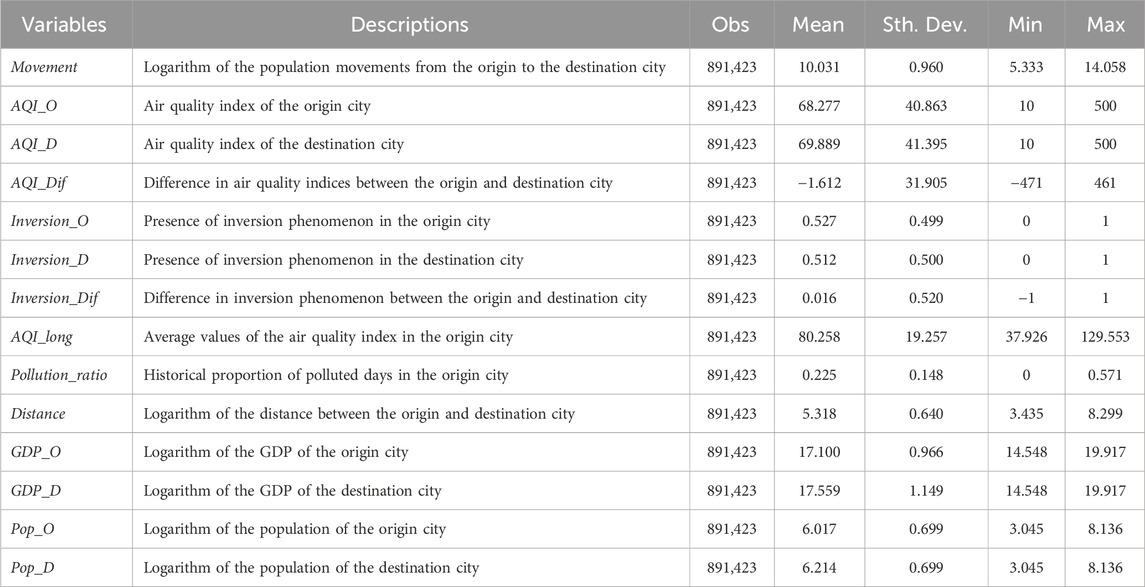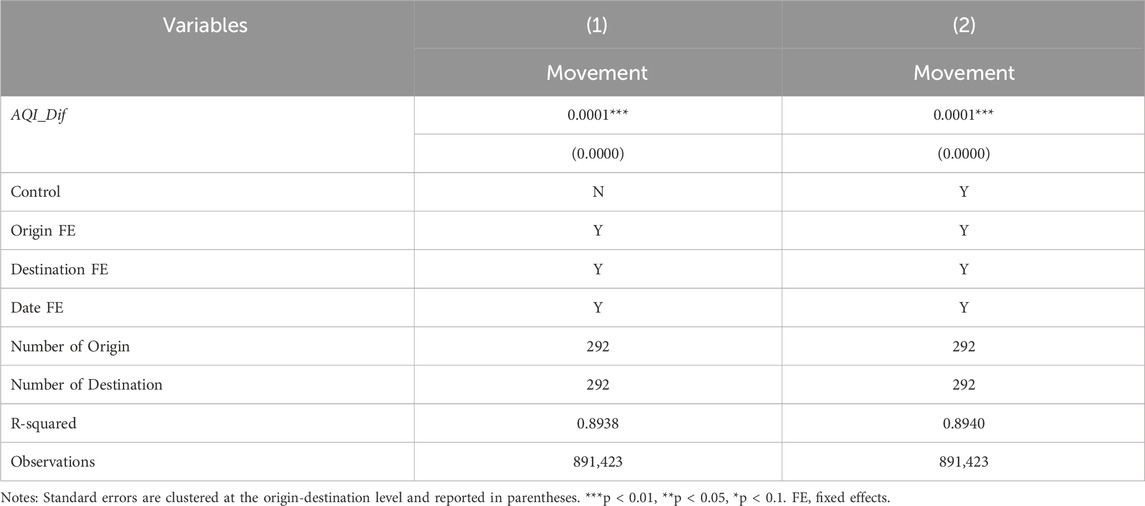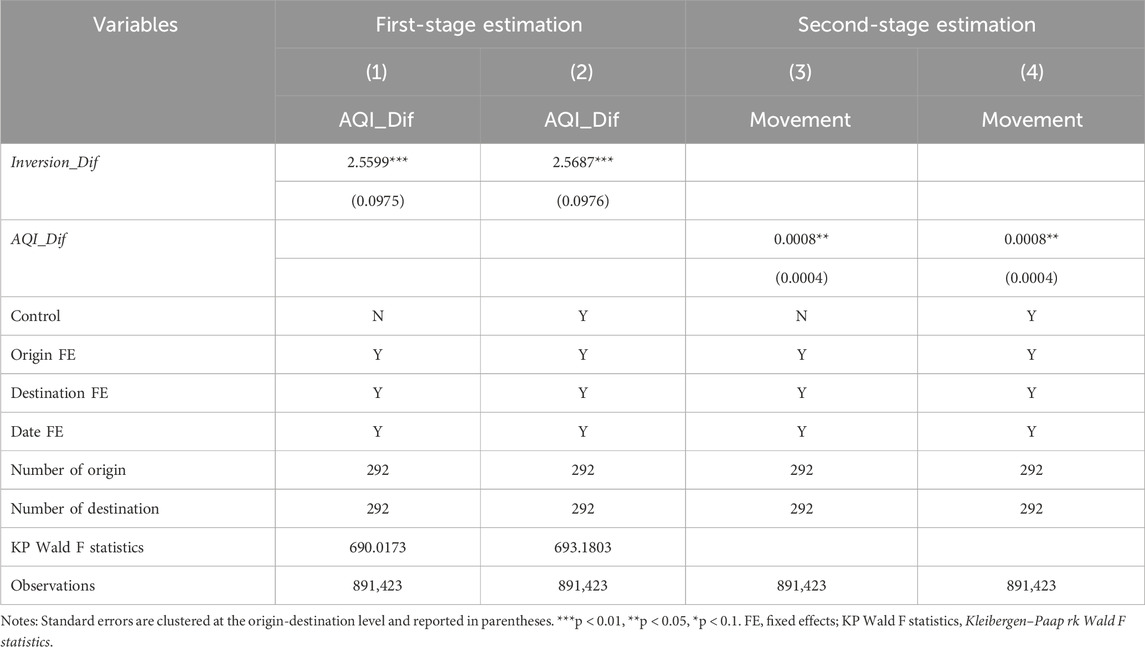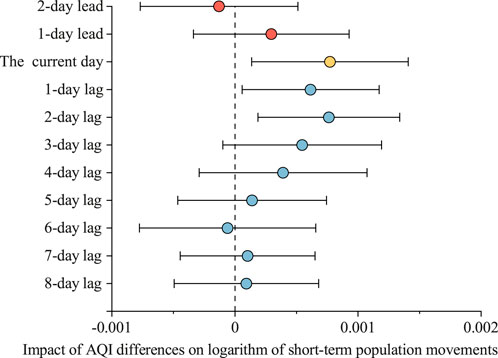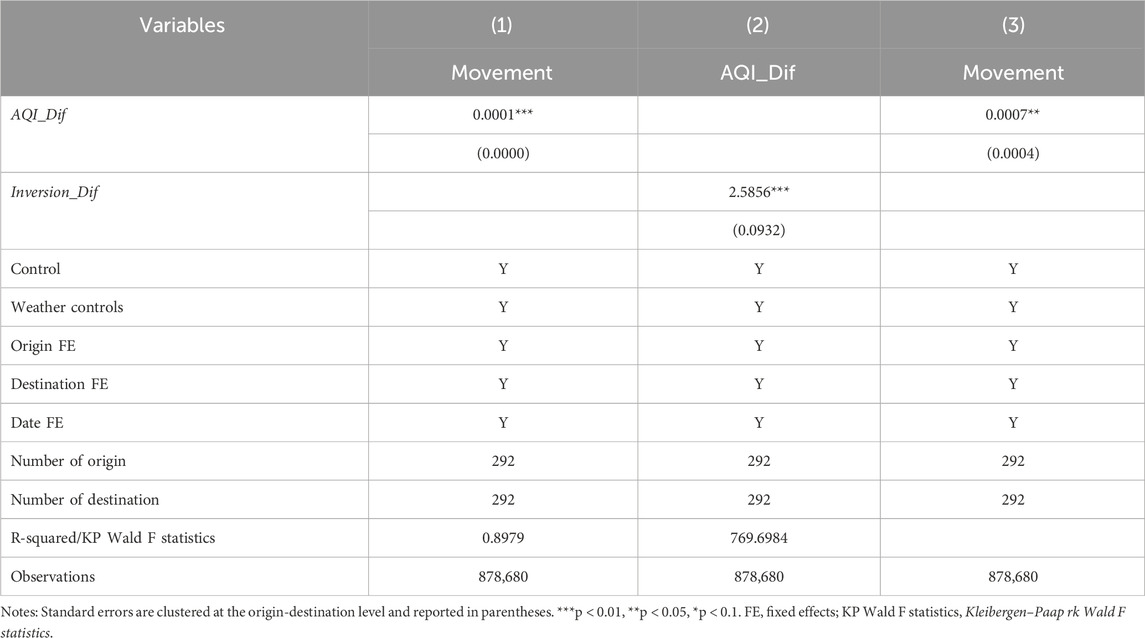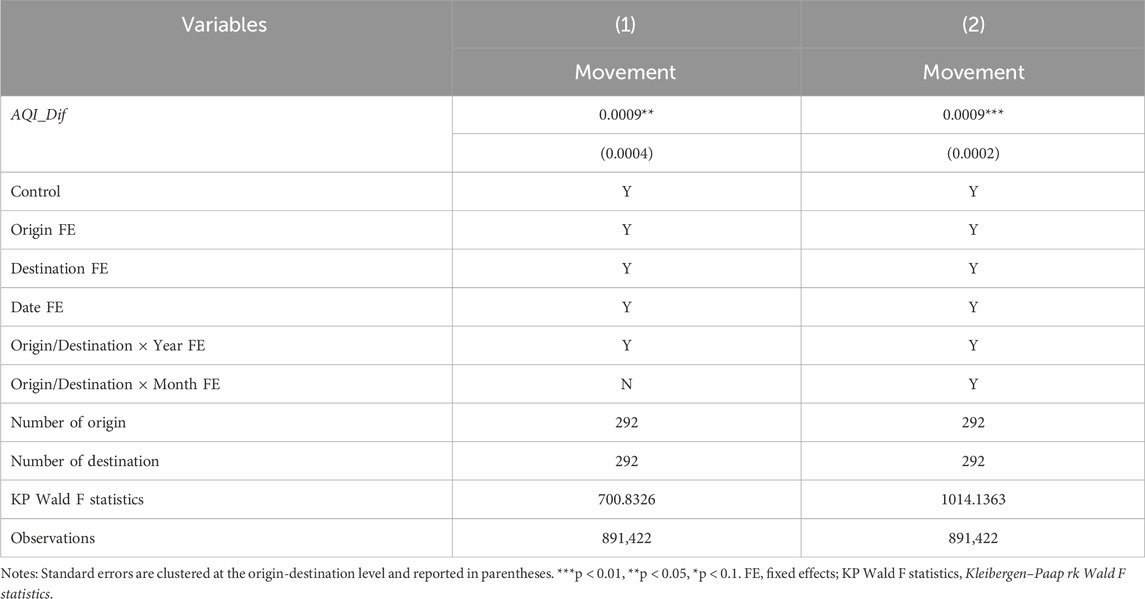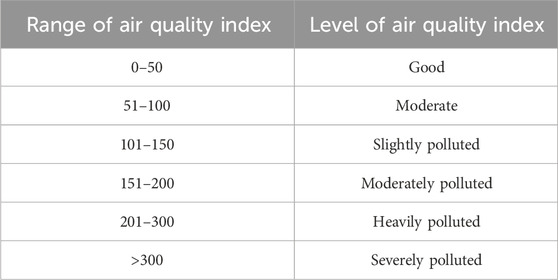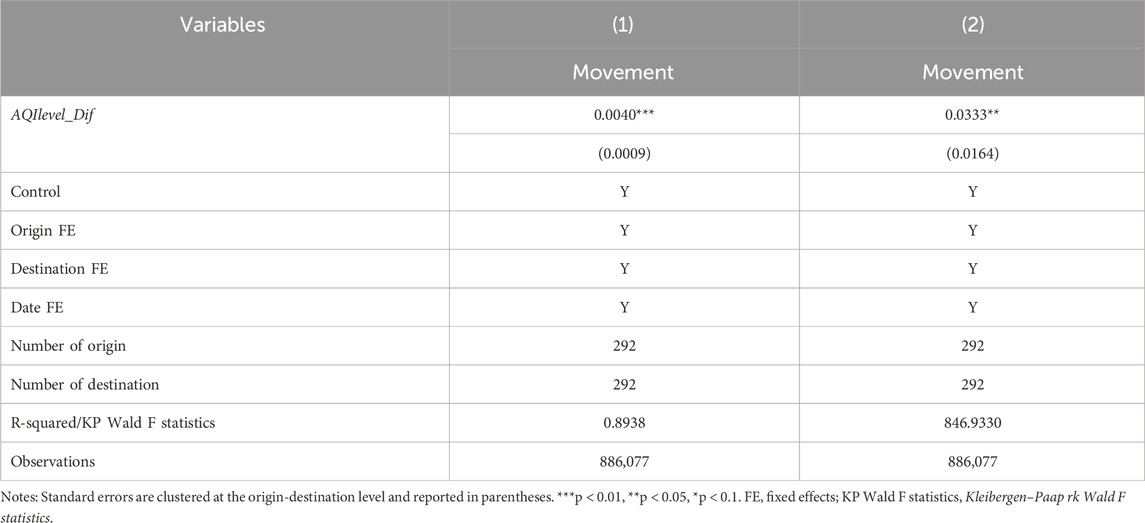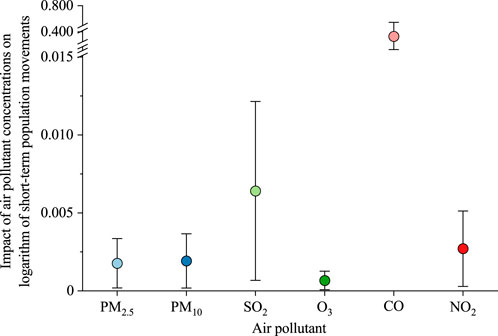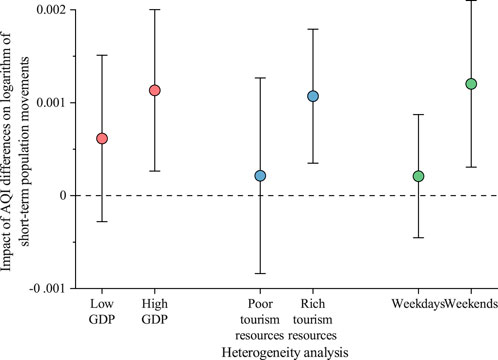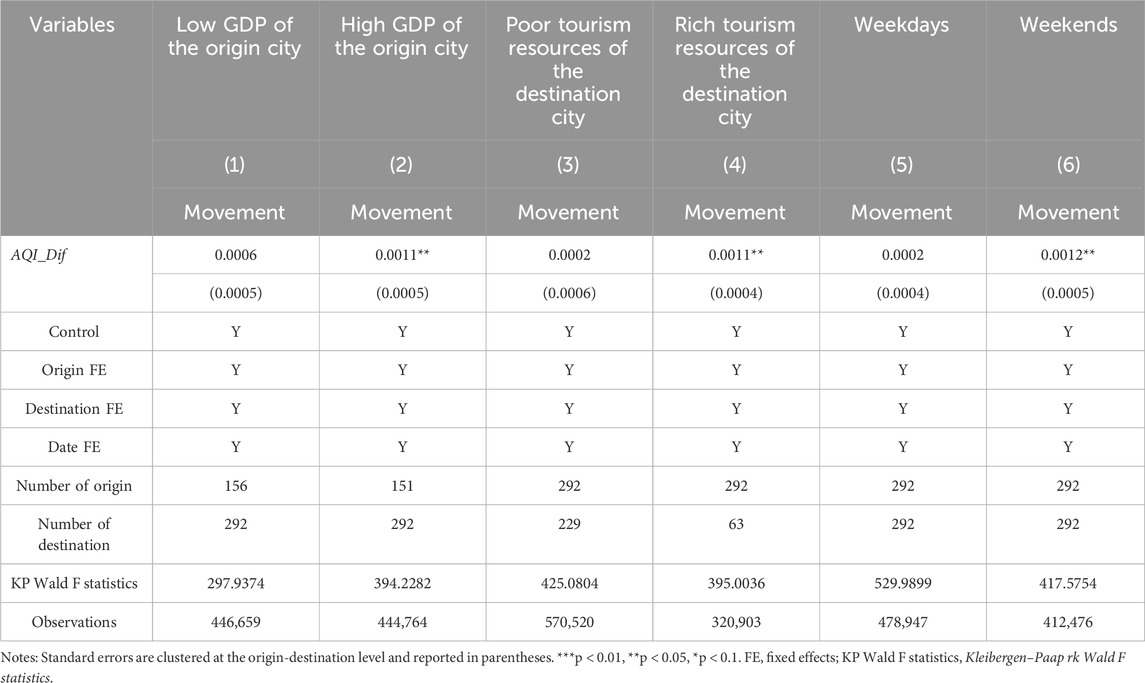- 1Institute of Energy, Environment and Economy, Tsinghua University, Beijing, China
- 2School of Foreign Languages, Renmin University of China, Beijing, China
- 3School of Economics and Management, South China Agricultural University, Guangzhou, China
- 4Agricultural Economics Department, Faculty of Agriculture, Fayoum University, Fayoum, Egypt
Introduction: While permanent migration has been extensively studied as a health-protective strategy for residents to avoid air pollution, national-level evidence regarding the short-term movement as a potentially more cost-effective measure remains limited.
Methods: This study used the instrumental variable approach to empirically examine the effect and mechanism of air pollution on short-term population movements in China by using a cross-city daily panel dataset.
Results: Our results showed that air pollution significantly promotes short-term population movements. A 100-unit increase in the air quality index at the origin city relative to the destination city led to an 8% rise in short-term movements. Residents tended to relocate only after pollution events occurred. The willingness to temporarily escape from air pollution was stronger under lower economic constraints, with more recreational opportunities and more available time. Moreover, long-term adaptation to historical air pollution weakened residents’ willingness to leave in response to local pollution events, reducing the potential health benefits of short-term movements by 44.49%.
Discussion: This study provides valuable insights into the motivations and mechanisms of residents’ decisions to temporarily relocate to feasibly and flexibly reduce pollution exposure and related health risks.
1 Introduction
Air pollution presents a considerable challenge to global sustainable development. Approximately 99% of the world’s population resides in areas where air pollution exceeds safe levels, with low- and middle-income countries being the most affected (World Health Organization, 2022). China, the largest developing nation, has undergone rapid economic growth since the 1980s, resulting in considerable environmental costs, with air pollution being a primary concern (Huang H. et al., 2021). The World Health Organization (WHO) introduced updated global air quality guidelines in 2021 and recommended that the annual average PM2.5 concentration should not exceed 5 μg/m31. However, no city in China currently meets this standard (Sun Y. et al., 2024). Exposure to air pollution negatively affects residents’ physical and mental health (Graff Zivin and Neidell, 2013). For instance, the incidence of respiratory diseases and the risk of diseases such as diabetes, cancer, cardiovascular diseases, and dementia will be notably increased (Tan et al., 2018; Sun M. et al., 2024; Xue et al., 2020; Fan et al., 2023). Moreover, air pollution exerts profound and enduring effects on residents’ life satisfaction and emotional well-being, contributing to a higher risk of anxiety and depression (Buoli et al., 2018; Mei et al., 2024; Wang and Liu, 2024). The resulting damage to physical and mental health further depletes human capital and harms social welfare. Therefore, mitigating the negative impact of air pollution on society has become a major issue.
In addition to public policies on controlling air pollution, individuals may adopt health-protective behaviors to mitigate the detrimental effects. Deschênes et al. (2017) argued that individuals weigh the adverse effects of pollution against the costs of avoiding exposure. Consequently, when exposed to air pollution, individuals typically engage in defensive investments to maximize their welfare. Empirical studies support this theory by identifying various health-protective measures such as using air purifiers, limiting outdoor activities, and wearing protective masks. Migration is one of the most crucial health-protective strategies (Pu et al., 2024; Mendes et al., 2020; Ma et al., 2023). Liu et al. (2022) highlighted that population migration can significantly reduce the health challenges associated with PM2.5, as relocating to regions with improved air quality can lower the mortality risks linked to pollution. Aunan and Wang (2014) revealed that from 2000 to 2010, internal migration in China generated health benefits of approximately $1.86 billion, or 0.24% of the gross domestic product (GDP), by reducing exposure to air pollution.
Existing studies have largely focused on the effects of air pollution on permanent migration, with evidence from China indicating that air pollution frequently prompts people to relocate their workplaces or places of residence (Chen et al., 2022; Guo et al., 2022; Feng et al., 2021). Similar trends have been observed in Germany (Farzanegan et al., 2023), Italy (Germani et al., 2021), and Iran (Rüttenauer and Best, 2022). These studies typically rely on multi-year air quality datasets that aggregate pollution metrics on an annual basis. However, temporal aggregation presents two critical concerns. First, the use of annual averages introduces endogeneity issues because long-term air quality is often highly correlated with local socioeconomic factors, such as industrial composition and economic development trajectories, which are also determinants of migration. Second, this approach overlooks short-term fluctuations in air quality, which may directly influence migration behavior. Residents can temporarily move to cleaner areas when air quality worsens and return when conditions improve. Such short-term movements serve as a kind of effective strategy to reduce the health risks posed by air pollution.
Short-term movements refer to temporary relocation in which individuals leave their usual place of residence for a limited period, with the intention of returning in the near future (Xia, 2024). Short-term movements differ notably from permanent migration, which involves a long-term resettlement accompanied by changes in household registration, employment base, or social integration. A short-term movement may be triggered by various purposes, including health protection, tourism, or business. Air pollution can directly induce health-related relocation and indirectly prompt individuals to leave polluted areas under the guise of tourism or business travel (Lam et al., 2021). In particular, compared to long-term migration, short-term movements provide a more feasible manner of avoiding pollution while reducing the associated costs (Chen et al., 2020). However, only limited studies have examined short-term movements as a form of health investment aimed at avoiding pollution exposure. Xia (2024) examined changes in residential travel demand from polluted to less polluted areas in Chengdu, China. Chen et al. (2020) analyzed the effect of air pollution on flight passenger numbers at Beijing International Airport, and Gao et al. (2023) investigated the effect of seasonal variations in air quality on mapping population movements. These studies concluded that deteriorating air quality encourages short-term relocation among local residents. However, these studies focused on specific transportation modes, seasons, or geographic areas, which has led to substantial sample selection bias. Therefore, a more comprehensive national-scale analysis is crucial to assess the effect of air pollution on short-term movements.
This study used daily data on city-level air quality and cross-city population movements in China to comprehensively analyze the impact and mechanism of air pollution on short-term movements. To make a reliable causal inference, we adopted the instrumental variable approach to address concerns of endogeneity. Furthermore, we revealed the role of long-term adaptation to historical pollution in this causal link by employing a moderation model.
The contributions of this study are threefold. First, although the impact of air pollution on permanent migration has been discussed in prior literature, this paper is one of the initial few studies that evaluated its impact on short-term population movements. We contribute to this gap by demonstrating that short-term migration is a more feasible and widespread response to air pollution, taking place about 11 times as often as permanent migration. This finding advances our understanding of how residents adopt low-cost strategies to protect their health against pollution exposure.
Second, we addressed the sample selection bias present in existing research through substantial improvements in data. Previous studies often relied on localized datasets, thereby focusing on specific regions, seasons, or transportation modes (Xia, 2024; Chen et al., 2020; Gao et al., 2023). By using Global Positioning System-based movement data from digital map applications, our study captured the nationwide effect of daily air pollution on population movements.
Finally, we accounted for the pivotal role of long-term adaptation in shaping residents’ health-protective measures. While previous studies suggested that adaptation can reduce health risks, we highlighted that long-term adaptation to air pollution may actually weaken individuals’ willingness to adopt health-protective measures, thereby increasing their exposure risks. On this point, our study reveals the long-lasting legacy of air pollution and underscores the urgency to safeguard clean air and protect public health.
The structure of this paper is as follows. Section 2 reviews the literature and puts forward two key hypothesis. Section 3 describes the data and methodology. Section 4 presents and analyzes the empirical results. Section 5 examines the moderating role of long-term adaptation and assesses health benefits. Section 6 summarizes the key findings and outlines directions for future research.
2 Literature review and hypothesis development
Two theoretical frameworks explain the impact of air pollution on population movements: the health capital theory and the push-pull theory (Sangkaew et al., 2025; Fu et al., 2024; Liu et al., 2024). According to health capital theory, individuals engage in preventive investments to avoid health deterioration from forthcoming pollution. When air quality worsens, residents decide to reduce outdoor activities and adopt protective measures to safeguard their health. Under conditions of more severe pollution, relocation emerges as a rational form of health investment to mitigate risks (Liu et al., 2024). On the other hand, the push-pull theory emphasizes the psychological aversion induced by environmental hazards. Air pollution leads to reduced visibility, worsened traffic conditions, and unpleasant smells (Peng and Xiao, 2018), all of which undermine immediate well-being and contribute to negative emotional responses such as irritability and depression (Kandola and Hayes, 2023; Xu et al., 2017; Liu et al., 2021). These psychological stressors push individuals to leave polluted areas.
Both permanent migration and short-term movements can help individuals avoid exposure to air pollution (Chen et al., 2020), but they differ significantly in terms of decision-making costs and underlying motivations. Short-term movements in response to air pollution provide a more feasible and flexible solution than that of permanent migration. The Chinese household registration system (hukou) restricts the feasibility of inter-city permanent relocation, as residents who migrate across regions probably encounter considerable obstacles in obtaining a local hukou in their destination area, which limits their access to public benefits, such as quality education for children and housing subsidies (Song, 2014; Chen et al., 2021). In contrast, short-term movements provide more economic advantages and lower risks than permanent relocation (Nawrotzki and DeWaard, 2016; McLeman, 2011), as they avoid major life decisions such as switching jobs and purchasing property.
Emotional impulses and herd behavior further contribute to residents’ willingness to temporarily relocate in response to air pollution. Severe pollution episodes can trigger sudden and intense negative emotions, prompting residents to leave distressing environments through short-term movements. Many studies have found that people tend to move to suburban or rural areas during holidays in search of cleaner air and psychologically restorative environments (Poudyal et al., 2013; Bielska et al., 2022). Furthermore, due to the widespread negative externalities of air pollution on public health, urban residents may exhibit bandwagon effects in adopting health-protective behaviors. Utami and Baroto (2025) presented evidence of herd behavior in the purchase of air purifiers. Similarly, Qin and Zhu (2018) found that air pollution increases the frequency of online searches for terms like “run away”, which reflects growing online discussion around temporary relocation and may further stimulate short-term movement behavior. Based on these analyses, we proposed Hypothesis 1.
Hypothesis 1. Air pollution encourages residents to make short-term moves.
Adaptation refers to the process of making adjustments to existing systems in response to current and anticipated environmental impacts, and it plays a key role in residents’ responsive coping mechanisms to environmental shocks (IPCC, 2022). Within this framework, active adaptation denotes intentional behavioral responses to mitigate exposure to air pollution, such as wearing masks or using air purifiers. In contrast, passive adaptation involves involuntary or unconscious adjustments to environmental changes. For instance, prolonged exposure to polluted air may lead individuals to underestimate associated health risks, resulting in decreased engagement in protective behaviors and, consequently, diminished health benefits. This phenomenon, known as risk perception attenuation in behavioral economics, suggests that the perceived risks of environmental hazards diminish as pollution persists (Slovic, 1987). In other words, past experiences with air pollution continue to influence the current mobility patterns of residents. Even after air quality improves, residents may still retain previous perceptions of air pollution (Feng et al., 2021; Wang et al., 2021). Adapting to historical pollution can reduce residents’ awareness of environmental hazards, thereby affecting the adoption of health-protective measures. Hackney et al. (1976) found that residents who experienced unusually high levels of O3 and other oxidants exhibited fewer clinical or physiological responses to O3 than newcomers. Thus, prolonged exposure to pollution can reduce residents’ willingness to relocate in response to short-term pollution and weaken the potential health benefits of such movements. Therefore, we proposed Hypothesis 2.
Hypothesis 2. Long-term adaptation to air pollution negatively moderates the impact of air pollution on residents’ short-term movements.
3 Research design and methods
3.1 Research framework
This study employed a systematic framework comprising regression analysis, case studies, scenario analysis, and environmental benefit assessments to examine how individuals respond to air pollution through short-term movements as a strategy for protecting their health, as well as the moderating role of long-term adaptation (Figure 1).
3.2 Data sources
The dataset used in this study was integrated from various sources. Daily inter-city population movement data were provided by Baidu Maps, one of China’s largest map service applications, with approximately 540 million active users2. Baidu Maps leverages Global Positioning System (GPS) technology to monitor users’ location data and determine whether they have traveled across cities, thereby enabling the calculation of daily population movements between any pair of cities. These movements are generally considered to be short-term and real-time in nature, and such data have been widely used to analyze population responses to temporary large-scale events, such as movements induced by the Spring Festival in China (Zhang and Gao, 2024). However, This dataset has rarely been linked with environmental data in previous research. In this study, we used this dataset to construct an indicator of short-term population movements, so as to examine relocation responses to air pollution. Because the data were not directly available, we obtained them from the Harvard Database (https://dataverse.harvard.edu) and Macrodatas (https://www.macrodatas.cn). Air quality data were sourced from the China Air Quality Monitoring and Analysis Platform (https://www.aqistudy.cn/?ref=www.940i.cn), which provides city-level daily concentrations of six major pollutants: PM2.5, PM10, SO2, NO2, O3, and CO, along with the air quality index (AQI), a composite measure reflecting overall pollution conditions. The temperatures of different atmospheric layers were obtained from the Modern-Era Retrospective Analysis for Research and Applications version 2 (MERRA-2), a satellite-based meteorological dataset released by the National Aeronautics and Space Administration. The city-level economic and social characteristics were obtained from the China City Statistical Yearbook, and geographic data were extracted from the National Platform for Common GeoSpatial Information Services.
After data collection, the following procedures were applied for data cleaning: (1) Only large-scale movement samples were retained, specifically those in which the number of citizens traveling to a destination exceeded 1% of the total daily outflow from the origin city for at least two consecutive days. This approach preserves useful information on short-term movements while reducing computational burden. (2) Only observations with no missing or abnormal values for key variables were kept. (3) Movement data during China’s Spring Festival were excluded, as this period is characterized by an exceptional surge in population mobility owing to the Chinese tradition of returning to hometowns for family reunions. For example, on the last day of China’s Spring Festival holiday in 2022, the total number of travelers reached its highest level in 188 cities, accounting for more than half of China’s cities. Following these procedures, we obtained a daily panel dataset of origin-destination pairs across 292 cities from 2021 to 2022, totaling 891,423 observations.
3.3 Descriptions of variables
3.3.1 Short-term population movements
The dependent variable is the logarithm of daily population movements from the origin to destination cities. Xia (2024) identified population flows in Chengdu, China by using confidential mobile phone data, which essentially rely on GPS signals to determine whether individuals have made inter-city moves and to calculate the daily number of movements. Similarly, we used GPS-based data from Baidu Maps to capture short-term population movements. This dataset allows us to observe daily movements between any pair of cities across China, thereby reducing the risk of sample selection bias. Because Baidu Maps provides a movement-based index rather than actual values, we used a linear conversion factor of 3.24 × 10-5 to convert the index into numbers of actual movements (Wang and Yan, 2021). A logarithmic transformation was then applied to reduce the skewness.
3.3.2 Air pollution
The AQI is the official indicator to measure and monitor air pollution in China. The AQI ranges from 0 to 500, with higher values signifying worse air quality. Following Chen et al. (2020), the key explanatory variable is the difference in the AQI between the destination and origin cities.
3.3.3 Instrumental variable
Similar to previous studies (Chen et al., 2022), we used temperature inversion as the instrumental variable to address potential endogeneity issues. Temperature inversion is a short-term natural phenomenon driven solely by meteorological conditions. It often occurs within a thin atmospheric layer, where the temperature increases with altitude rather than decreasing normally (Trinh et al., 2019). Temperature inversion hinders mass and energy exchange between atmospheric layers, preventing pollutants from dispersing upward (Li et al., 2012). This traps pollutants near the ground and worsens air quality. Because temperature inversion is closely linked to air pollution while remaining exogenous to other determinants of population movements, it meets the criteria for a valid instrumental variable in this context.
Following Chen et al. (2020), we first calculated the average temperature for the corresponding grid area of each city in each layer. We then compared the average temperatures in the first atmospheric layer (110 m height) and the second atmospheric layer (320 m height). If the temperature at a lower altitude was lower than that at a higher altitude, the inversion was recorded. As outlined by Fu et al. (2021), we assigned a value of 1 to the inversion variable if an inversion occurred on a given day and 0 otherwise. The difference in inversion values between the destination and origin cities was used as the instrumental variable.
3.3.4 Moderating variable
Similar with Lai et al. (2022), the moderating variable is long-term air pollution, which was measured by two indicators: the average AQI values and the proportion of polluted days. A day was considered polluted if the AQI exceeded 100, which corresponded to a “slightly polluted” level. Considering that AQI has been widely adopted by Chinese authorities since 2014, we calculated these two indicators based on the average values from 2014 to 2020.
3.3.5 Control variable
In the classical gravity model, population movements are driven primarily by economic development, geographical distance, and population size. Consistent with this framework, control variables include GDP and population of both the origin and destination cities, along with the geographical distance between them (Rosselló Nadal and Santana Gallego, 2022). Table 1 presents summary statistics of main variables.
3.4 Empirical strategy
To assess the impact of air pollution on short-term population movements, we formulated the following equation based on a gravity model from the literature (Fracasso, 2014; Xia, 2024):
In Equation 1, i and j represent the origin and destination city, respectively. Movementijt represents population outflows from city i to city j on date t. AQIit and AQIjt are the air quality indices of cities i and j on date t, respectively. Controlsijt is the vector of control variables. ui, vj, and wt represent the origin, destination, and date fixed effects, respectively. εijt is the error term. The coefficient β1 captures the impact of AQI differences on population movements.
Baseline estimations encounter endogeneity concerns, such as bidirectional causality and omitted variable bias. To address endogeneity issues, we employed temperature inversion as the instrumental variable and constructed a two-stage least squares (2SLS) model as follows:
where Inversionit - Inversionjt represents the difference in temperature inversion between cities i and j.
To verify Hypothesis 2, we examined the role of adaptation to long-term air pollution by developing the following moderation model:
where AQI_longi and Pollution_ratioi represent the historical average AQI values and the proportion of polluted days, respectively, capturing the long-term air pollution characteristics in city i. We estimated Equations 4, 5, using the instrumental variable approach. As adaptation to long-term pollution reduces residents’ willingness to escape from pollution, we expected negative values of coefficients μ2 and λ2.
4 Results and discussions
4.1 Baseline estimations
Before performing regression analysis, we assessed the multicollinearity among the explanatory variables. The maximum variance inflation factor was 2.65, well below the conventional threshold of 10. Table 2 presents the results of Equation 1. All regressions control for city and date fixed effects, and regression in column (2) further incorporates control variables. The preferred estimate in column (2) reveals that the AQI differences between the origin and destination cities significantly increased daily population movements at the 1% level, indicating a tendency for people to relocate from areas with elevated air pollution. This provides preliminary support for Hypothesis 1.
4.2 Instrumental variable estimations
Baseline estimates may be subject to endogeneity. Large-scale population movements can lead to a reduction in fuel and electricity consumption in the origin city, both of which are major sources of air pollution (Perera, 2017). Moreover, short-term individual movements are influenced by various hard-to-quantify factors such as emergencies, vacation activities, and work commitments, leading to omitted variable bias in city-level analyses.
To address these concerns, we implemented the 2SLS models to avoid estimation bias. As shown in columns (1) and (2) of Table 3, the temperature inversion significantly contributed to air pollution at the 1% level. Temperature inversion suppresses the vertical atmospheric circulation, thereby preventing pollutants and water vapor from dispersing upward. Furthermore, gaseous pollutants may dissolve in water and undergo oxidation, generating secondary pollutants that aggravate air pollution (Zhong et al., 2017; Wu et al., 2018; Huang Q. et al., 2021). The Kleibergen–Paap rk Wald F statistic was 693.18, indicating that temperature inversion serves as an ideal predictor of air quality, thus confirming the eligibility of the instrumental variable.
Using the instrumental variable approach, air pollution positively affected population movements with a larger coefficient than that of the baseline estimation. As shown in columns (3) and (4) of Table 3, a 100-unit increase in the AQI in the city of origin relative to the destination led to an 8% increase in population movements. This figure is more reliable because the instrumental variable mitigates endogeneity concerns.
4.3 Lead–lag effects estimations
We further explored the motivations behind residents’ short-term movement decisions. Rather than responding solely to current air pollution events, residents may proactively avoid future air pollution or take measures to recover from previous pollution. Similar to Chen et al. (2020), we separately replaced AQI_Dif with lead or lag terms in Equations 2, 3, to analyze its dynamic effects on population movements.
No leading effect of air pollution was observed on population movements; however, a short-term lag effect was identified (Figure 2). The results showed that air pollution had no significant impact on short-term movements occurring one or 2 days in advance. One possible explanation is that owing to the uncertainty of weather forecasts and additional economic costs, initiating measures against air pollution earlier is a less cost-effective strategy Chen et al. (2020). Furthermore, the AQI differences between the origin and destination cities significantly influenced population movements on the current day and up to 2 days afterward. This short-term lag effect was probably due to information delays and the persistence of air pollution. After perceiving the adverse impacts of pollution on health, residents are eager to relocate to areas with better air quality for recovery (Hemmati et al., 2020; Bielska et al., 2022). However, owing to the urgency of recovery, from the third day onward, the effect of air pollution gradually diminished to zero (Cui et al., 2019; Gao et al., 2023).
4.4 Robustness checks
4.4.1 Controlling weather conditions
In the baseline regression, we primarily controlled for economic and social factors to maintain consistency with the standard form of the gravity model, which may have overlooked the influence of weather conditions. Weather makes a difference in two key ways. On one hand, it is closely linked to air quality. For example, extreme ozone and PM2.5 events are more common in winter and summer (Zhang et al., 2017; Liu et al., 2023). On the other hand, weather directly affects mobility decisions. Extreme weather events prompt individuals to cancel trips or alter their destinations (Cools and Creemers, 2013; Singhal et al., 2014). Therefore, we incorporated the daily weather conditions of both the origin and destination cities as control variables, including daily temperature, wind gusts, dew point, and visibility, thereby controlling for the effects of temperature, wind, humidity, and overall comfort. Columns (1)–(3) of Table 4 present the regression results of both the baseline and 2SLS estimations after adding weather control variables. In all models, the coefficients of AQI_Dif and Inversion_Dif remained significantly positive. This consistency suggests that omitted variable bias is unlikely to have a notable effect (Altonji et al., 2005).
4.4.2 Controlling high-dimensional fixed effects
Although many fixed effects are considered the baseline regression, cities may experience significant variations across different periods. Consequently, we introduced high-dimensional fixed-effects regression models to further control for unobserved dynamic factors in population movements (Wee et al., 2018; Zhang et al., 2024). Columns (1) and (2) of Table 5 present the estimation results of the 2SLS models after incorporating the origin/destination year and origin/destination month fixed effects. The coefficient of AQI_Dif remained significantly positive, thereby demonstrating the robustness of Hypothesis 1.
4.4.3 Replacing measurement of air quality indices
Next, we conducted robustness checks by replacing measurement of the key explanatory variables. We classified continuous AQI values into six levels based on the official classification system (Table 6). Accordingly, we used the differences in AQI levels between the origin and destination cities as the key explanatory variable and revised Equations 1–3.
Columns (1) and (2) of Table 7 present the baseline and 2SLS estimation results, respectively. As shown in the preferred estimations in column (2), when the air quality of the original city was one level worse than that of the destination city, population movements increased by 3.33%. Considering that the AQI is a composite index comprising six pollutants, we also examined the effect of each pollutant on population movements under 2SLS estimations. Increases in air pollutant concentrations led to significant short-term population movements (Figure 3). Notably, the effects of atmospheric ozone pollution on movements were the smallest of the six pollutants. This finding, in line with Liu and Yu (2020), likely indicates the relatively lower health damage caused by short-term ozone exposure compared with that of other pollutants (Guan et al., 2022).
4.4.4 Conducting alternative research samples
We transformed the data structure into a city-daily panel, including the daily AQI and population outflow of each prefecture-level city to assess whether regional air quality deterioration exacerbated short-term population outflows. First, we conducted estimations for each province based on aggregated city-level data. Twenty-four of the 31 provinces exhibited a positive relationship between worsening air quality and increasing population outflow, with only a few regions, such as Hainan, Xinjiang, and Xizang, deviating from this pattern (Figure 4A). Hainan, an island province, has limited transportation options available for local residents to relocate. High-cost maritime and air transport reduces residents’ willingness to leave during periods of air pollution. In Xinjiang and Xizang, the vast areas and sparse transportation networks impose greater time and economic costs for moving, reducing the possibility of residents taking leave in response to air pollution. In addition, we conducted separate estimations for each city and plotted the distribution of coefficients based on the regression results (Figure 4B). A similar finding was confirmed, with air quality deterioration leading to population outflow in most cities. On average, a 100-unit AQI increase was associated with a 2%–5% increase in population outflow.
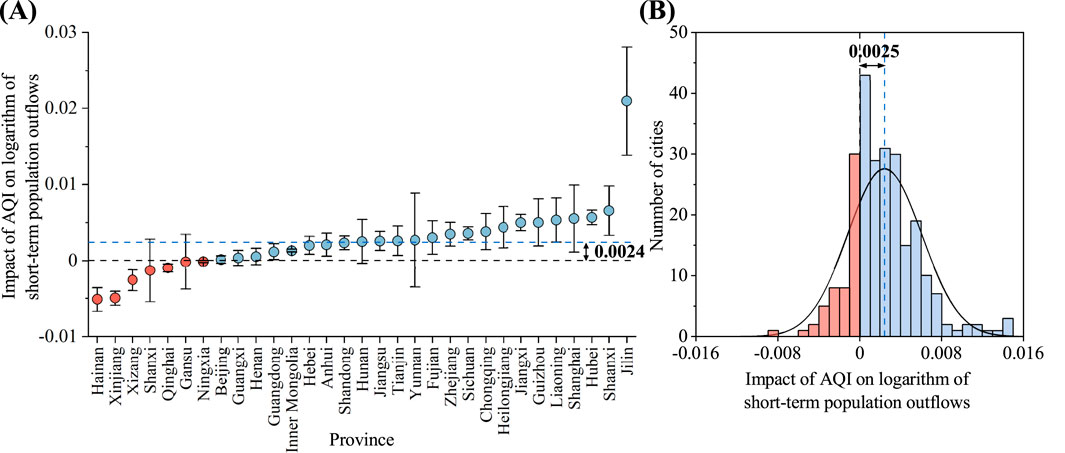
Figure 4. Impact of the air quality index on short-term population outflows. (A) Estimation results using provincial panel data; (B) Estimation results using city-level panel data. If the Kleibergen-Paap rk Wald F statistic exceeds 10, we employed the 2SLS estimations; otherwise, ordinary least squares estimations.
4.5 Heterogeneity analysis
To investigate the heterogeneity in pollution-induced movement responses, we further stratified our analytical sample based on three dimensions: costs, purposes, and timing of movements.
First, inter-city movements require economic support, implying that regional economic development influences the ability of residents to travel in response to air pollution. We divided our sample based on the median GDP per capita of the original city and then performed Equations 2, 3, for each subsample. As shown in Figure 5 and columns (1) and (2) of Table 8, in origin cities with high economic development, for every 100-unit increase in AQI differences, population movements increased by 11%, with the coefficient statistically significant at the 5% level. However, the corresponding figure was only 6% in cities with low economic development and was not significant. Residents in wealthier areas are more aware of air pollution risks and tend to have greater financial capacity for traveling, making them more likely to move away as pollution levels increase. By contrast, people in less affluent areas have a lower willingness and ability to pay for clean air, leading to weaker responses (Feng et al., 2021).
Second, because short-term movements are primarily influenced by the desire to escape from air pollution and recover from prior exposure, residents may be more inclined to visit tourist cities to acquire recreational opportunities. 5A-grade scenic spots represent a city’s top tourism resource, attracting 1.21 billion visitors annually, far exceeding lower-tier scenic spots3. Therefore, we used the number of 5A-grade scenic spots to measure a city’s tourism resources, divided the samples based on the median number of such spots in the destination cities, and performed grouped regressions. As shown in Figure 5 and columns (3) and (4) of Table 8, a 100-unit increase in AQI differences significantly led to an 11% increase in short-term movements to destinations with abundant tourism resources but only a 2% increase with poor tourism resources. Cities with abundant tourism resources are more likely to fulfill residents’ recreational needs, making them the top choice for destination selection (Gao et al., 2023).
Finally, the timing of air pollution events is also a notable factor. According to China’s 2020 Census, approximately 63.35% of the country’s population was of working age (15–59 years) (National Bureau of Statistics of China, 2021). Individuals who are physically more capable of traveling must consider work time-related constraints when making movement decisions. Therefore, their willingness to leave during air pollution depends on whether they are on a weekday or weekend. We reran Equations 2, 3, separately on weekdays and weekends. Notably, Friday is considered part of the weekend primarily because it is conceptually linked to post-work leisure (Da Silva et al., 2024), and traveling on Friday allows for extended trips. As shown in Figure 5 and columns (5) and (6) of Table 8, on weekends, a 100-unit increase in AQI differences significantly led to a 12% increase in population movements at the 1% level, whereas on weekdays, the increase was only 2% and was insignificant. Employment creates a “retention effect”, trapping populations in polluted locations and limiting their mobility, as evidenced by Chen et al. (2020) and Gao et al. (2023).
5 Further discussion
5.1 Moderating roles of long-term adaptation
According to Hypothesis 2, the sensitivity of resident movements to air pollution is moderated by prolonged exposure to air pollution. To test this hypothesis, we employed a 2SLS model to estimate Equation 4. Columns (1) and (2) of Table 9 present the results. The coefficient of AQI_Dif remained significantly positive, thus supporting H1. The interaction terms between AQI_Dif and the two moderating variables (AQI_long and Pollution_ratio) were both significantly negative at the 1% level. Specifically, with a 100-unit increase in the short-term AQI, if residents experienced a 1-unit increase in the long-term historical AQI, their population movements decreased by 1%. Similarly, under the same 100-unit pollution shock, if residents experienced an additional day of pollution per year (0.27% increase in the pollution ratio), their population movements decreased by 0.16%.
These findings indicate that prolonged exposure to pollution promotes adaptation, decreasing the willingness of short-term movements in response to pollution events, thereby favoring Hypothesis 2. To further ensure robustness, we replaced the key explanatory variable and moderating variables with the daily PM2.5 concentration differences between the origin and destination cities, as well as long-term PM2.5. All coefficients remained consistent with expectations (column 3 of Table 9).
5.2 Estimations of savings by values of a statistical life
Another rationale for incorporating PM2.5 in analysis is that its concentrations are strongly associated with human health, enabling us to assess health impacts. Using severe pollution events in 2024 as a case study, we conducted a scenario analysis to quantify the effects of short-term movements and long-term adaptation. The baseline scenario captured the combined effects of both, whereas the counterfactual scenario assumed no long-term adaptations. We evaluated the interaction between short-term movements and long-term adaptation in response to air pollution by comparing the values of a statistical life (VSL) savings in these two scenarios.
In China, severe pollution is defined as an AQI above 200, which is equivalent to a PM2.5 concentration over 150.5 μg/m34. To simulate the effect of severe pollution, we first defined a representative city with a PM2.5 concentration close to the national average of 29.3 μg/m3 in 20245 and daily movements of 27,493 people based on our sample’s average values. We then imposed a severe pollution shock to this city, increasing the PM2.5 concentration from 29.3 to 150.5 μg/m3, that is, a deterioration of 121.2 μg/m3. Column (3) of Table 7 shows that a 1 μg/m3 increase in PM2.5 concentration led to a 0.18% increase in short-term movements. Consequently, short-term movements were expected to increase by 21.82% or 5,998 additional movements, owing to daily severe pollution events. Ma et al. (2024) noted that for every 10 μg/m3 increase in short-term PM2.5 concentration, the all-cause daily mortality rate per 100,000 individuals increases by 0.01. Therefore, relocating to cities with lower concentrations (29.3 μg/m3) rather than remaining in a highly polluted city (150.5 μg/m3) can potentially prevent 0.01 deaths per day per city. We then used the VSL estimate of 4.7 million Chinese Yuan (CNY) per death to convert the prevented deaths into economic value (Wang et al., 2024), resulting in VSL savings of 34,166 CNY per day per city. Considering that approximately 0.9% of the days in 2024 were expected to be affected by severe pollution5, annual VSL savings amounted to 38.05 million CNY in China.
In the counterfactual scenario, we attempted to exclude the effects of long-term adaptation, meaning that the long-term air quality remained fresh, with the historical average PM2.5 concentration at 29.3 μg/m3. The marginal effect was calculated as 0.62%–0.01% × 29.3 = 0.33% (column 3 of Table 9), which was higher than 0.19% in the baseline scenario. Residents with no previous exposure to pollution were more sensitive to severe pollution. Severe pollution events resulted in an increase of 10,851 movements. The total VSL savings were 68.55 million CNY under this scenario.
These results are based on two important assumptions. First, owing to the limitations of the reduced-form estimation, we did not account for adaptation measures other than short-term movements. Although some measures, such as wearing masks, have been proven to have limited impact (Zhang and Mu, 2018), this remains a risky assumption. Second, we assumed that only the origin city was polluted while all destination cities remained clean, which is consistent with existing literature (Gao et al., 2023). We satisfied this assumption by analyzing only severe pollution, as such events rarely occur. Although overlooking other adaptation measures may lead to overestimation, we believe that the above findings primarily underestimated VSL savings for the following four reasons. (1) A minimum impact of severe pollution was adopted in calculations. If more severe pollution events occurred (e.g., PM2.5 reaching 500 μg/m3), the results would increase by up to 15 times higher than current estimates. (2) Only all-cause mortality was considered, which underestimated the effects of PM2.5 on chronic, long-term, and mental health conditions (Sun et al., 2023; Tsai et al., 2024; Zhang et al., 2022). (3) Only the immediate health effects of air pollution on same-day population movements were accounted for; however, subsequent movements could also help avoid health losses. (4) Severe pollution events, rather than overall pollution events, were estimated. Ma et al. (2024) highlighted that health losses become apparent when PM2.5 exceeds 10 μg/m3; however, we only estimated the effects of extreme pollution events, which represent the most notable part in reality.
These extended scenario analyses were useful in identifying the effects of both short-term movements and long-term adaptation. With and without considering long-term adaptation, a severe air pollution event led to an increase of 5,998 and 10,851 people in movement, accounting for 22% and 39% of the daily population outflows, respectively. This underscores that air pollution is a major driver of short-term movements. To contextualize our findings, we compared our estimates with results from the literature on permanent migration. Guo et al. (2022) found that for every 1 μg/m3 increase in long-term (15 years) PM2.5 concentration, the probability of individual migration increased by 2.51%. This implies an additional 113,100 long-term migrants in an average-sized city with a population of 4.5 million. In contrast, the number of short-term movements totals 1.28 million over a period of 15 years, which is 11.32 times that of permanent migration. This finding highlights the fact that short-term movements are more feasible and cost-effective strategies than permanent migration against air pollution. In addition, long-term exposure to air pollution reduces the VSL benefits of short-term movements by 44.49%. In historically polluted areas, residents have gradually become accustomed to air pollution and tend to overlook its associated health risks. Fan (2024) demonstrated that prolonged exposure to air pollution results in individuals notably reducing physical exercise rather than compensating for it afterward or transitioning to indoor activities. Similarly, our study reveals that long-term adaptation to air pollution imposes notable health risks, an issue that is particularly critical in low-income countries where residents may simultaneously suffer from long-term pollution exposure and lack access to effective protective measures.
6 Conclusion
The impact of air pollution on permanent migration has been extensively studied (Guo et al., 2022; Rüttenauer and Best, 2022; Farzanegan et al., 2023); however, nationwide evidence on its effect on short-term movements in China remains limited. This research discussed the impact of air pollution on short-term population movements using cross-city daily panel dataset and exhibited the underlying mechanisms. To address potential endogeneity concerns, we employed temperature inversion as an instrumental variable. Our findings indicated that a 100-unit increase in AQI in the origin city relative to the destination leads to an 8% increase in short-term movements. This suggests that residents consider engaging in short-term movements a viable coping strategy for air pollution, positioning it as a crucial form of health investment (Lu et al., 2022). Moreover, according to our study, short-term movements occurred 11.32 times more frequently than long-term migration, likely owing to their feasibility and cost-effectiveness as a health-protective response to air pollution.
A dynamic analysis revealed that air pollution does not have a leading effect on short-term movements but exhibits a lag effect. This indicates that residents do not relocate proactively based on pollution forecasts. However, considering the persistence of air pollution and the necessity to recover from historical pollution events, individuals tend to relocate to cleaner areas within 3 days of air pollution strikes. Additionally, the impact of air pollution on short-term movements is more pronounced in origin cities with higher economic development, in destination cities with more high-quality scenic resources, and on weekends. These findings highlight the critical roles of economic constraints, recreational opportunities, and available leisure time in influencing travel decisions in response to air pollution.
Furthermore, we incorporated long-term adaptation to air pollution into the discussion of pollution-induced short-term movements. Prolonged exposure to high pollution reduces residents’ sensitivity to short-term fluctuations, thus reducing their willingness to move. Specifically, long-term adaptation reduced the benefits of short-term movements in response to air pollution by 44.49%. Based on these findings, mitigating air pollution should be considered a long-term priority. Effective measures include sustained investments in clean production technologies and stricter regulations on high-emission sectors such as industry, transportation, and energy. Moreover, because adaptation to pollution exacerbates health risks, governments should strengthen their healthcare systems by enhancing medical support for populations chronically exposed to high levels of pollution. In addition, to alleviate the environmental pressure on high-pollution urban centers, policymakers can encourage population flows toward mid-sized cities or suburban areas with better air quality. This strategy can reduce pollution exposure as well as promote the development of livable urban clusters, promoting a positive interaction between environmental sustainability and economic growth.
Despite these findings, this study had certain limitations. First, owing to the absence of micro-level survey data on population movements, we relied on GPS-based data from Baidu Maps to track short-term movements. Although Baidu Maps is one of the most widely used mapping applications in China, capturing around 36.96% of the market in 20246, our dataset potentially induced bias by overlooking individuals who use alternative mapping services or those with limited access to smartphones and mapping applications. Additionally, owing to data constraints, our analysis was limited to inter-city movements, potentially omitting intra-regional mobility, particularly urban-to-rural movements within the same city. Future research can enhance accuracy by using more granular data, such as grid-level data, to better capture patterns of population movements. Finally, this study focused solely on the health impacts of long-term adaptation to air pollution on movement decisions without considering other potential consequences. Because prolonged exposure to air pollution is a crucial issue in many mid- and low-income countries, future studies should examine wider implications of pollution adaptation on lifestyle behaviors, health investments, and physical and mental wellbeing.
Data availability statement
The data analyzed in this study is subject to the following licenses/restrictions: Datasets are available on request due to privacy restrictions. Requests to access these datasets should be directed to BW, d2J3MjNAbWFpbHMudHNpbmdodWEuZWR1LmNu.
Author contributions
CL: Visualization, Software, Funding acquisition, Writing – original draft, Methodology, Conceptualization, Writing – review and editing, Formal Analysis. XY: Formal Analysis, Writing – original draft, Conceptualization, Funding acquisition, Writing – review and editing, Methodology. BW: Writing – original draft, Formal Analysis, Methodology, Writing – review and editing, Validation, Supervision. AA: Formal Analysis, Writing – review and editing, Supervision.
Funding
The author(s) declare that financial support was received for the research and/or publication of this article. This research was funded by “Case China” project of Renmin University of China (grant number RUCCX2021146).
Conflict of interest
The authors declare that the research was conducted in the absence of any commercial or financial relationships that could be construed as a potential conflict of interest.
Generative AI statement
The author(s) declare that no Generative AI was used in the creation of this manuscript.
Publisher’s note
All claims expressed in this article are solely those of the authors and do not necessarily represent those of their affiliated organizations, or those of the publisher, the editors and the reviewers. Any product that may be evaluated in this article, or claim that may be made by its manufacturer, is not guaranteed or endorsed by the publisher.
Footnotes
1PM2.5 refers to atmospheric particulate matter that have a diameter of less than 2.5 μm. It is a type of air pollution that has a significant negative impact on air quality and visibility.
2The number of active users on Baidu Maps reached 539.79 million in December 2023. Data source: QuestMobile.
3Data source: Investment Banking Research Center of the Industrial and Commercial Bank of China.
4Data source: The World Air Quality Index Project.
5Data source: Ministry of Ecology and Environment.
6Data source: iiMedia Research.
References
Altonji, J. G., Elder, T. E., and Taber, C. R. (2005). Selection on observed and unobserved variables: assessing the effectiveness of Catholic schools. J. Polit. Econ. 113 (1), 151–184. doi:10.1086/426036
Aunan, K., and Wang, S. (2014). Internal migration and urbanization in China: impacts on population exposure to household air pollution (2000–2010). Sci. Total Environ. 481, 186–195. doi:10.1016/j.scitotenv.2014.02.073
Bielska, A., Borkowski, A. S., Czarnecka, A., Delnicki, M., Kwiatkowska-Malina, J., and Piotrkowska, M. (2022). Evaluating the potential of suburban and rural areas for tourism and recreation, including individual short-term tourism under pandemic conditions. Sci. Rep. 12, 20369. doi:10.1038/s41598-022-24503-z
Buoli, M., Grassi, S., Caldiroli, A., Carnevali, G. S., Mucci, F., Iodice, S., et al. (2018). Is there a link between air pollution and mental disorders? Environ. Int. 118, 154–168. doi:10.1016/j.envint.2018.05.044
Chen, S., Chen, Y., Lei, Z., and Tan-Soo, J. S. (2020). Impact of air pollution on short-term movements: evidence from air travels in China. J. Econ. Geogr. 20 (3), 939–968. doi:10.1093/jeg/lbaa005
Chen, S., Chen, Y., Lei, Z., and Tan-Soo, J. S. (2021). Chasing clean air: pollution-induced travels in China. J. Assoc. Environ. Resour. Econ. 8 (1), 59–89. doi:10.1086/711476
Chen, S., Oliva, P., and Zhang, P. (2022). The effect of air pollution on migration: evidence from China. J. Dev. Econ. 156, 102833. doi:10.1016/j.jdeveco.2022.102833
Cools, M., and Creemers, L. (2013). The dual role of weather forecasts on changes in activity-travel behavior. J. Transp. Geogr. 28, 167–175. doi:10.1016/j.jtrangeo.2012.11.002
Cui, C., Wang, Z., He, P., Yuan, S., Niu, B., Kang, P., et al. (2019). Escaping from pollution: the effect of air quality on inter-city population mobility in China. Environ. Res. Lett. 14 (12), 124025. doi:10.1088/1748-9326/ab5039
Da Silva, S., Matsushita, R., and Korzenowski, E. (2024). Why is friday better than sunday? J. Interdisc. Econ. 36 (1), 98–104. doi:10.1177/02601079221083490
Deschênes, O., Greenstone, M., and Shapiro, J. S. (2017). Defensive investments and the demand for air quality: evidence from the NOx budget program. Am. Econ. Rev. 107 (10), 2958–2989. doi:10.1257/aer.20131002
Fan, M., Jiang, H., and Zhou, M. (2023). Beyond particulate matter: new evidence on the causal effects of air pollution on mortality. J. Health Econ. 91, 102799. doi:10.1016/j.jhealeco.2023.102799
Fan, Y. (2024). Social cost of lifestyle adaptation: air pollution and outdoor physical exercise. J. Environ. Econ. Manag. 127, 103042. doi:10.1016/j.jeem.2024.103042
Farzanegan, M. R., Gholipour, H. F., and Javadian, M. (2023). Air pollution and internal migration: evidence from an Iranian household survey. Empir. Econ. 64 (1), 223–247. doi:10.1007/s00181-022-02253-1
Feng, X., Ma, S., Wen, L., and Zhao, Y. (2021). Immediate effect of air pollution on labor mobility: empirical evidence from online résumé data. Ann. Reg. Sci. 67 (3), 483–512. doi:10.1007/s00168-021-01055-0
Fracasso, A. (2014). A gravity model of virtual water trade. Ecol. Econ. 108, 215–228. doi:10.1016/j.ecolecon.2014.10.010
Fu, J., Fu, H., Zhu, C., Sun, Y., Cao, H., and Deng, X. (2024). The impact of air pollution on residents’ health in China: the mediating effect of population migration. Air Qual. Atmos. Health. 17, 1281–1293. doi:10.1007/s11869-024-01506-5
Fu, S., Viard, V. B., and Zhang, P. (2021). Air pollution and manufacturing firm productivity: nationwide estimates for China. Econ. J. 131 (638), 3241–3273. doi:10.1093/ej/ueab033
Gao, Y., Zhang, L., and Nan, Y. (2023). Travel to breathe the fresh air? Big data evidence on the short-term migration effect of air pollution from China. China Econ. Rev. 82, 102070. doi:10.1016/j.chieco.2023.102070
Germani, A. R., Scaramozzino, P., Castaldo, A., and Talamo, G. (2021). Does air pollution influence internal migration? An empirical investigation on Italian provinces. Environ. Sci. Policy. 120, 11–20. doi:10.1016/j.envsci.2021.02.005
Graff Zivin, J., and Neidell, M. (2013). Environment, health, and human capital. J. Econ. Lit. 51 (3), 689–730. doi:10.1257/jel.51.3.689
Guan, Y., Xiao, Y., Zhang, N., and Chu, C. (2022). Tracking short-term health impacts attributed to ambient PM2.5 and ozone pollution in Chinese cities: an assessment integrates daily population. Environ. Sci. Pollut. R. 29 (6), 91176–91189. doi:10.1007/s11356-022-22067-z
Guo, Q., Wang, Y., Zhang, Y., Yi, M., and Zhang, T. (2022). Environmental migration effects of air pollution: micro-level evidence from China. Environ. Pollut. 292, 118263. doi:10.1016/j.envpol.2021.118263
Hackney, J. D., Linn, W. S., Buckley, R. D., and Hislop, H. J. (1976). Studies in adaption to ambient oxidant air pollution: effects of ozone exposure in Los Angeles residents vs. new arrivals. Environ. Health Persp. 18, 141–146. doi:10.1289/ehp.7618141
Hemmati, F., Dabbaghi, F., and Mahmoudi, G. (2020). Relationship between international tourism and concentrations of PM2.5: an ecological study based on WHO data. J. Environ. Health Sci. 18 (8), 1029–1035. doi:10.1007/s40201-020-00524-6
Huang, H., Wang, F., Xiao, Y., and Kuang, J. (2021). Towards the coupling coordination relationship between economic growth quality and environmental regulation: an empirical case study of China. Discrete Dyn. Nat. Soc. 1, 1–16. doi:10.1155/2021/2563335
Huang, Q., Chu, Y., and Li, Q. (2021). Climatology of low-level temperature inversions over China based on high-resolution radiosonde measurements. Theor. Appl. Climatol. 144 (1), 415–429. doi:10.1007/s00704-021-03536-w
IPCC (2022). Climate change 2022: impacts, adaptation, and vulnerability. Contribution of working group II to the sixth assessment report of the intergovernmental panel on climate change. London: Cambridge University Press. doi:10.1017/9781009325844
Kandola, A., and Hayes, J. F. (2023). Real-time air pollution and bipolar disorder symptoms: remote-Monitored cross-sectional study. BJPsych. Open 9 (4), e107. doi:10.1192/bjo.2023.77
Lai, W., Li, S., Liu, Y., and Barwick, P. J. (2022). Adaptation mitigates the negative effect of temperature shocks on household consumption. Nat. Hum. Behav. 6 (6), 837–846. doi:10.1038/s41562-022-01315-9
Lam, J. C., Li, V. O., Han, Y., Zhang, Q., Lu, Z., and Gilani, Z. (2021). In search of bluer skies: would people move to places of better air qualities? Environ. Sci. Policy. 117, 8–15. doi:10.1016/j.envsci.2020.12.012
Li, Y., Yan, J., and Sui, X. (2012). Tropospheric temperature inversion over central China. Atmos. Res. 116, 105–115. doi:10.1016/j.atmosres.2012.03.009
Liu, H., Chen, Y., and Ma, L. (2021). Effect of time-varying exposure to air pollution on subjective well-being. J. Clean. Prod. 281, 125364. doi:10.1016/j.jclepro.2020.125364
Liu, S., Liu, C., Hu, Q., and Gao, M. (2023). Distinct responses of PM2.5 and O3 extremes to persistence of weather conditions in eastern China. Atmos. Environ. 309, 119923. doi:10.1016/j.atmosenv.2023.119923
Liu, Y., Zhu, G., Zhao, Z., Sabel, C. E., Ma, Z., Jiao, Z., et al. (2022). Population aging might have delayed the alleviation of China’s PM2.5 health burden. Atmos. Environ. 270, 118895. doi:10.1016/j.atmosenv.2021.118895
Liu, Z., Yin, H., and Zhang, X. (2024). Tradeoff between air pollution and economic benefits in migration dynamics: evidence from China. Struct. Change Econ. Dyn. 71, 669–679. doi:10.1016/j.strueco.2024.09.010
Liu, Z., and Yu, L. (2020). Stay or leave? The role of air pollution in urban migration choices. Ecol. Econ. 177, 106780. doi:10.1016/j.ecolecon.2020.106780
Lu, J., Li, H., and Xu, M. (2022). Does haze aggravate urban sprawl? Habitat Int. 130, 102709. doi:10.1016/j.habitatint.2022.102709
Ma, S., Li, X., Li, D., and Guo, H. (2023). Does air pollution induce international migration? New evidence from Chinese residents. Econ. Model 120, 106176. doi:10.1016/j.econmod.2022.106176
Ma, Y., Nobile, F., Marb, A., Dubrow, R., Stafoggia, M., Breitner, S., et al. (2024). Short-term exposure to fine particulate matter and nitrogen dioxide and mortality in 4 countries. Jama Netw. Open 7 (1), e2354607. doi:10.1001/jamanetworkopen.2023.54607
McLeman, R. A. (2011). Settlement abandonment in the context of global environmental change. Glob. Environ. Chang. 21 (1), S108–S120. doi:10.1016/j.gloenvcha.2011.08.004
Mei, Y., He, J., and Luo, N. (2024). Traffic exhaust pollution and residents’ happiness: analysis from China general social survey (CGSS) data. Curr. Psychol. 43 (18), 16113–16137. doi:10.1007/s12144-023-05527-8
Mendes, F. C., Paciência, I., Rufo, J. C., Silva, D., Cunha, P., Farraia, M., et al. (2020). The inflammatory potential of diet impacts the association between air pollution and childhood asthma. Pediat. Allerg. Imm. 31 (3), 290–296. doi:10.1111/pai.13185
National Bureau of Statistics of China (2021). The seventh national population census bulletin. Available online at: https://www.stats.gov.cn/sj/pcsj/rkpc/d7c/202111/P020211126523667366751.pdf (Accessed April 2, 2025).
Nawrotzki, R. J., and DeWaard, J. (2016). Climate shocks and the timing of migration from Mexico. Popul. Environ. 38 (1), 72–100. doi:10.1007/s11111-016-0255-x
Peng, J., and Xiao, H. (2018). How does smog influence domestic tourism in China? A case study of Beijing. Asia Pac. J. Tour. Res. 23 (12), 1115–1128. doi:10.1080/10941665.2018.1527776
Perera, F. P. (2017). Multiple threats to child health from fossil fuel combustion: impacts of air pollution and climate change. Environ. Health Persp. 125 (1), 141–148. doi:10.1289/EHP299
Poudyal, N. C., Paudel, B., and Green, G. T. (2013). Estimating the impact of impaired visibility on the demand for visits to national parks. Tour. Econ. 19 (2), 433–452. doi:10.5367/te.2013.0204
Pu, L., Zhu, Y., Shi, X., Wang, H., Pan, D., He, X., et al. (2024). Health impacts of lifestyle and ambient air pollution patterns on all-cause mortality: a UK biobank cohort study. BMC Public Health 24 (1), 1696. doi:10.1186/s12889-024-19183-5
Qin, Y., and Zhu, H. (2018). Run away? Air pollution and emigration interests in China. J. Popul. Econ. 31 (1), 235–266. doi:10.1007/s00148-017-0653-0
Rosselló Nadal, J., and Santana Gallego, M. (2022). Gravity models for tourism demand modeling: empirical review and outlook. J. Econ. Surv. 36 (5), 1358–1409. doi:10.1111/joes.12502
Rüttenauer, T., and Best, H. (2022). Perceived pollution and selective out-migration: revisiting the role of income for environmental inequality. J. Ethn. Migr. Stud. 48 (15), 3505–3523. doi:10.1080/1369183X.2022.2030211
Sangkaew, N., Wichupankul, S., Cheng, X., and Han, H. (2025). Exploring traveller willingness to shift towards air pollution-free destinations: developing the multiple configurations of push, pull, and mooring factors. Curr. Issues Tour. 2, 1–19. doi:10.1080/13683500.2025.2462189
Singhal, A., Kamga, C., and Yazici, A. (2014). Impact of weather on urban transit ridership. Transp. Res. A-Pol. 69, 379–391. doi:10.1016/j.tra.2014.09.008
Song, Y. (2014). What should economists know about the current Chinese hukou system? China Econ. Rev. 29, 200–212. doi:10.1016/j.chieco.2014.04.012
Sun, D., Liu, C., Zhu, Y., Yu, C., Guo, Y., Sun, D., et al. (2023). Long-term exposure to fine particulate matter and incidence of esophageal cancer: a prospective study of 0.5 million Chinese adults. Gastroenterology 165 (1), 61–70.e5. doi:10.1053/j.gastro.2023.03.233
Sun, M., Zhao, N., and Zheng, E. (2024). The devil in the air: air pollution and dementia. J. Environ. Econ. Manag. 127, 103020. doi:10.1016/j.jeem.2024.103020
Sun, Y., Jiang, Y., Xing, J., Ou, Y., Wang, S., Loughlin, D., et al. (2024). Air quality, health, and equity benefits of carbon neutrality and clean air pathways in China. Environ. Sci. Technol. 58 (35), 15027–15037. doi:10.1021/acs.est.3c10076
Tan, C., Wang, Y., Lin, M., Wang, Z., He, L., Li, Z., et al. (2018). Long-term high air pollution exposure induced metabolic adaptations in traffic policemen. Environ. Toxicol. Phar. 58, 156–162. doi:10.1016/j.etap.2018.01.002
Trinh, T. T., Trinh, T. T., Le, T. T., Nguyen, T. D. H., and Tu, B. M. (2019). Temperature inversion and air pollution relationship, and its effects on human health in Hanoi City, Vietnam. Environ. Geochem. Health 41, 929–937. doi:10.1007/s10653-018-0190-0
Tsai, H. H., Tantoh, D. M., Lu, W., Chen, C., and Liaw, Y. P. (2024). Cigarette smoking and PM2.5 might jointly exacerbate the risk of metabolic syndrome. Front. Public Health 11, 1234799. doi:10.3389/fpubh.2023.1234799
Utami, I. I., and Baroto, W. A. (2025). The perception of air purifiers on indoor air quality: effective or human herd behavior? City built. Environ. 3 (1), 6. doi:10.1007/s44213-025-00047-6
Wang, C., and Yan, J. (2021). Inversion of the baidu migration scale index construction method. J. Univ. Electron. Sci. Technol. China 04, 616–626. 10.12178/1001-0548.2020441.
Wang, J., and Liu, X. (2024). Climate change, ambient air pollution, and students’ mental health. World J. Psychiatr. 14, 204–209. doi:10.5498/wjp.v14.i2.204
Wang, Z., Ma, J., Zhang, B., and Wang, B. (2021). Air pollution and urban population migration: evidence from household smart meter big data. Manag. World 37 (3), 19–33. doi:10.19744/j.cnki.11-1235/f.2021.0033
Wang, Y., Jin, Y., Lin, H., Wan, W., and Zhang, S. (2024). Valuing mortality risk reductions in a fast-developing society: a meta-analysis of stated preference studies in China from 1998 to 2019. Soc. Sci. Med. 363, 117471. doi:10.1016/j.socscimed.2024.117471
Wee, S., Coffman, M., and La Croix, S. (2018). Do electric vehicle incentives matter? Evidence from the 50 US states. Res. Policy 47, 1601–1610. doi:10.1016/j.respol.2018.05.003
World Health Organization (2022). Billions of people still breathe unhealthy air: new WHO data. Geneva, Switzerland: World Health Organization. Available online at: https://www.who.int/news/item/04-04-2022-billions-of-people-still-breathe-unhealthy-air-new-who-data (Accessed April 5, 2025).
Wu, Y., Ge, X., Wang, J., Shen, Y., Ye, Z., Ge, S., et al. (2018). Responses of secondary aerosols to relative humidity and photochemical activities in an industrialized environment during late winter. Atmos. Environ. 193, 66–78. doi:10.1016/j.atmosenv.2018.09.008
Xia, C. (2024). The role of everyday mobility in adaptation to air pollution hazard: a mixed-method approach combining big and traditional data. Glob. Environ. Chang. 88, 102914. doi:10.1016/j.gloenvcha.2024.102914
Xu, W., Ding, X., Zhuang, Y., Yuan, G., An, Y., Shi, Z., et al. (2017). Perceived haze, stress, and negative emotions: an ecological momentary assessment study of the affective responses to haze. J. Health Psychol. 25 (4), 450–458. doi:10.1177/1359105317717600
Xue, Y., Chu, J., Li, Y., and Kong, X. (2020). The influence of air pollution on respiratory microbiome: a link to respiratory disease. Toxicol. Lett. 334, 14–20. doi:10.1016/j.toxlet.2020.09.007
Zhang, D., Bai, D., and Wang, Y. (2024). Green vs. brown: climate risk showdown–who’s thriving, who’s diving? J. Int. Money Financ. 149, 103198. doi:10.1016/j.jimonfin.2024.103198
Zhang, H., Wang, Y., Park, T. W., and Deng, Y. (2017). Quantifying the relationship between extreme air pollution events and extreme weather events. Atmos. Res. 188, 64–79. doi:10.1016/j.atmosres.2016.11.010
Zhang, J., and Mu, Q. (2018). Air pollution and defensive expenditures: evidence from particulate-filtering facemasks. J. Environ. Econ. Manag. 92, 517–536. doi:10.1016/j.jeem.2017.07.006
Zhang, T., Dou, J., Wang, L., Wang, S., Wang, P., Zhou, X., et al. (2022). Exposure to particulate pollutant increases the risk of hospitalizations for Sjögren's syndrome. Front. Immunol. 13, 1059981. doi:10.3389/fimmu.2022.1059981
Zhao, Y., and Gao, Y. (2024). Spatial analysis of population mobility in China in recent years: a study based on Baidu migration big data. Chin. Popul. Dev. Stud. 8, 287–309. doi:10.1007/s42379-024-00163-6
Zhong, J., Zhang, X., Wang, Y., Sun, J., Zhang, Y., Wang, J., et al. (2017). Relative contributions of boundary-layer meteorological factors to the explosive growth of PM2.5 during the red-alert heavy pollution episodes in Beijing in December 2016. J. Meteorol. Res. 31, 809–819. doi:10.1007/s13351-017-7088-0
Keywords: air pollution, short-term movements, long-term adaptation, health benefits, values of a statistical life, instrumental variable approach
Citation: Luo C, Yan X, Wang B and Ali A (2025) Long-term adaptation mitigates the promotion effect of air pollution on short-term population movements. Front. Environ. Sci. 13:1620499. doi: 10.3389/fenvs.2025.1620499
Received: 30 April 2025; Accepted: 20 June 2025;
Published: 14 July 2025.
Edited by:
Richard W. Baldauf, United States Environmental Protection Agency (EPA), United StatesReviewed by:
Xiao-Fei Gao, Pacific Northwest National Laboratory (DOE), United StatesJie Liu, University of Cambridge, United Kingdom
Copyright © 2025 Luo, Yan, Wang and Ali. This is an open-access article distributed under the terms of the Creative Commons Attribution License (CC BY). The use, distribution or reproduction in other forums is permitted, provided the original author(s) and the copyright owner(s) are credited and that the original publication in this journal is cited, in accordance with accepted academic practice. No use, distribution or reproduction is permitted which does not comply with these terms.
*Correspondence: Bowen Wang, d2J3MjNAbWFpbHMudHNpbmdodWEuZWR1LmNu
 Chongjia Luo
Chongjia Luo Xiaotong Yan
Xiaotong Yan Bowen Wang
Bowen Wang Abdelrahman Ali
Abdelrahman Ali